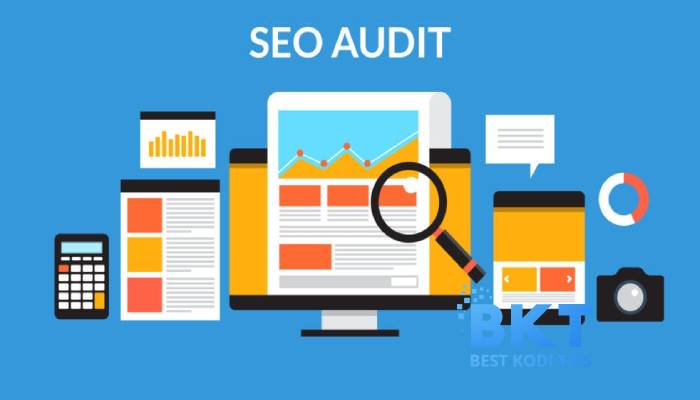If you’re reading this, you probably have no idea how to do a technical SEO audit. Don’t worry; even in 2021, many web admins have no idea how to get started. This tutorial aims to teach you what a technical SEO audit is, why it’s important, what factors affect your SEO performance, the X-step process of performing an SEO audit, so you can know how to do a website technical audit like a pro.
What Is a Technical SEO Audit and Why Does It Matter?
Long gone are the days of packing your website’s content with keywords and backlinking. Today, you need to improve your SEO game and create a strategy that fits modern developments in the SEO sphere.
A technical SEO audit is a process of evaluating the technicalities of your site’s SEO. In short, it checks how healthy your website’s SEO is and offers ways to optimize it.
Search engines like Google and Bing use bots that crawl billions of websites. These bots then compare your website’s content to its list of ranking factors before assigning a rank to your website. Obviously, the higher the rank you have, the higher up you’ll be on the SERP, which is good for your online business.
Before we dive too deep into the audit process, explain why an SEO audit is so important.
As a website owner, you’re probably fully aware of how much SEO contributes to your site’s success and failure. For many, it’s the primary reason why their online businesses attract customers. If you’re SEO isn’t up to snuff, you can’t complete it—it’s as simple as that.
So, in ensuring your website’s SEO prowess, employing robust backlink analysis tools like Serpstat becomes indispensable, offering comprehensive insights into competitors’ strategies, keyword optimization, and link-building opportunities to fortify your online presence.
Factors that Can Affect Your SEO Performance
The precise factors that affect your website’s SEO performance are held behind a proverbial vault in every search engine’s underground dungeon. However, through research and experience, I’ve boiled the most crucial performance-affecting factors into three categories: technical, on-page, and off-page factors. All of these factors require regular audits to guarantee that your website is always on top of the ever-changing conditions of your industry.
Technical Factors
Technical factors refer to server optimizations that ultimately help search engine bots crawl and index your website effectively. This can help improve your website’s organic rankings.
On-Page Factors
This is perhaps the factor that most website owners are familiar with. This involves the practice of optimizing your site based on specific keywords to improve search visibility and boost traffic. Things like content, headings, and internal links are all a part of on-page factors.
Off-Page Factors
Off-page optimization refers to every measure outside of your website to improve your SERP position. This includes making backlinks, social network marketing, and guest authoring.
How to Do a Website Audit: A 9-Step Process
Now that we’ve gotten the basic stuff out of the way, let’s focus on the crux of the matter: performing an SEO technical audit. Below, we’ll walk you through the nine steps you need to take to audit your website’s SEO effectively.
Step 1 | Crawl Your Website
The first thing you should do when conducting a technical SEO audit is to crawl your website. Make use of tools like Semrush to do so.
These website crawlers can identify problems, including broken links, problems with titles, and erroneous keywords. Furthermore, crawling your website will help you identify duplicate content and unlinked pages.
However, it all starts with your crawl budget. A crawl budget is the number of pages that Googlebot crawls and indexes within a certain timeframe. This figure will give you a clear idea of how Googlebot crawls your site.
Below, we’ll quickly go over how you can get the most out of your crawl budget.
Getting Rid of Duplicate Content
Duplicate content—pages with similar or identical titles and/or meta descriptions—and pages will take up too much of your crawl budget’s time. Using Semrush and other such tools, you can identify and remove duplicate pages quickly. Any duplicate content that you absolutely need to have can be blocked from search engine bots.
Restrict Indexation
To save your crawl budget, remove certain pages of your website from indexation. Pages like Privacy Policy and T&C usually don’t need to be included.
Include URL Parameters
It’s not uncommon for Googlebot to crawl the same page multiple times. Adding URL parameters via the Google Search Console will tell Googlebot to crawl the same page multiple times instead of two separate pages.
Correct Redirects
Every time Googlebot follows a redirect, it takes up more of your crawl budget. Reduce as many inefficient redirects as possible to help Googlebot its final destination for indexation.
Step 2 | Review the Sitemap
In short, your website’s sitemap is a list of all of the indexable pages. It’s essential to structure your website to help search engines discover new pages and content. While reviewing the sitemap, make sure that it fulfills the following checklist:
Clean
Ideally, your sitemap should not contain any errors. Faulty redirects and URLs that end up blocking indexing need to be eliminated to help search engine bots discover your sitemap.
Concise
Google’s policy is that if your sitemap contains more than 50,000 URLs, Googlebot won’t crawl it. Keep your sitemap as concise as possible by only including the most crucial, relevant pages.
Updated
To help search engine bots discover new content more quickly, make sure you include your latest content on the sitemap as soon as it’s published.
Registered
Most important, Google won’t know about your sitemap if you don’t register it. Open Google Search Console and follow the registration process.
Step 3 | Check Whether Your Website Has Multiple Browsable Versions
Are there various versions of your website? If so, you need to eliminate every additional version until you’re only left with one. Ignoring this step can confuse search engine bots regarding which version is the correct one to crawl and index. Ignoring this step can actually push your rankings down.
The most common errors are having duplicate HTTP and HTTPS versions and errors while creating a mobile-friendly website. After conducting the technical SEO audit, only one browsable version of your website should remain.
Ideally, your website will use HTTPS since over 50% of all front-page search results are HTTPS. It’ll also eliminate the “Not Secure” label next to your website, which can drive traffic away from your business.
Step 4 | Check the Health of Internal Links
It’s generally a good idea to check whether all internal and external links to your website are still functional. A broken link can cause web pages to shift around and become deleted, which isn’t good for Googlebot and indexing.
Here, we’ll go over what parts of internal linking you need to check during the audit. You can use WebSite Auditor or other free services to check for the following.
Click Depth
Click depth is defined as the number of clicks needed to reach your web site’s homepage from a particular page. Try to make this figure as low as possible or three at most.
Broken Links
You guessed it. Broken links waste your crawl budget. Also, they can confuse and irritate online users and turn them off of your website permanently. Again, WebSite Auditor can help you identify broken links. Just check for which links are broken and either delete or fix them.
Orphan Pages
An orphan page is a page on your website that isn’t linked to another page. Basically, a user has to know the URL if they want to visit that page. This is problematic for search engines, and most of the time, they’ll ignore it while indexing your site.
Step 5 | Test Your Website’s Loading Speed
Do you like waiting around for pages to load fully? I didn’t think so, and neither does anyone else. The longer it takes for a page to load, the likelier a visitor will skedaddle. Because of this, your technical SEO audit should include checking for your website’s loading speed.
Google now takes into account the site speed when determining your final rankings. They’ve created a handy tool—PageSpeed Insights—to help you determine your site speed. The ideal load time is between 2 and 5 seconds. If it takes longer than that, your bounce rate might skyrocket.
Step 6 | Check Your HTTPS Problems
As we stated earlier, the majority of websites that make the first page of Google are HTTPS. If your website already uses HTTPS, then you need to check it for common HTTPS problems. You’ll find what they are and how to correct them below.
Links and Redirects
All links, canonicals, and redirects must take you to an HTTPS page. It’s possible to have both HTTP and HTTPS redirects, though it’s not ideal since this can waste your crawl budget every time Googlebot encounters a redirect.
Unsecured Content
Content problems can arise when secure pages have to load unsecured content, such as pictures and videos. This can ultimately decrease your web page’s security, thus preventing browsers from loading it in its entirety. Again, using WebSite Auditor, you can help you identify mixed content problems and compile a comprehensive list of non-HTPPS resources.
Step 7 | Compare Site Metrics with Google Analytics
You have to check in with Google Analytics to see whether it’s reporting accurate data. If it is, then your code is installed and working properly. TO do this, place the Google Analytics tracker code above the header of every page and compare it with the “site:domain name” results. The figure should be identical or similar. If it isn’t, that means Googlebot may not crawl some web pages.
Step 8 | Conduct an SEO Backlinks Audit
Backlinks are arguably one of the most important factors in the success of your website and online business, and it comes as no surprise that your technical SEO audit should include an SEO backlinks audit. Backlinks show search engines how valuable your content is for users.
Ahrefs is an excellent tool that gives a full description of what backlinks are beneficial for your website. It can also identify what areas need more high-value links by checking what your competitors are doing.
Generating backlinks is a great way to get your business and brand out there. In an ideal world, you won’t have to rely on guest-posting on other web pages or social media since other people can help with natural link building. However, if you’re just starting or unfamiliar with the backlinking process, don’t fret—this affordable backlink service can help you get started.
Step 9 | Re-Crawl Your Website
After everything is said and done, we have to start at the beginning—namely, crawling your website. Repeating this step, in the end, can help ensure that any changes you’ve made to your web pages and sitemap have an effect.
To re-crawl your website, open Google Search Console, navigate to Crawl and select Fetch as Google. After Googlebot fetches your website, click on Submit to Index.
Now You’re Ready to Perform a Technical SEO Audit
Performing a technical SEO audit regularly can play a direct role in the success or failure of your SEO strategy and, ultimately, your online business. Doing so will help you spot problems to assess and correct them early.
Remember: make sure that there aren’t any delays in your website’s loading times and that internal linking is done appropriately and checked frequently. Conducing an SEO backlinks audit can further help you find out what areas of your website need optimizing.















Comments